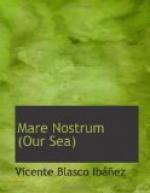They were all muscular and well set-up with blue eyes and blonde mustaches, and were wearing hidden medallions. One of them had presented to the cook one of his religious charms which he had bought on a pilgrimage to Ste. Anne d’Auray. Caragol was wearing it upon his hairy chest, and experiencing a new-born faith in the miracles of this foreign image.
“To her sanctuary, Captain, the pilgrims go in thousands. Every day she performs a miracle.... There’s a holy staircase there which the devout climb on their knees and many of these lads have mounted it. I should like ...”
On some of their voyages to Brest he was hoping that Ferragut would permit him to go to Auray long enough to climb that same stairway on his knees, to see Ste. Anne and return aboard ship.
The vessel was no longer in a commercial harbor. It had gone to a military harbor,—a narrow river winding through the interior of the city, dividing it in two. A great drawbridge put in communication the two shores bordered with vast constructions and high chimneys, naval shops, warehouses, arsenals, and dry-docks for cleaning up the boats. Tug-boats were continually stirring up its green and miry waters. Steamers undergoing repairs were lined up the length of the break-waters undergoing a continual pounding that made their plates resound. Lighters topped with hills of pit coal were going slowly to take their position along the flanks of the ships. Under the drawbridge launches were coming and going from the warships, leaving on the floating piers the crews celebrating their shore-leave with scandalous uproar.
The Mare Nostrum remained isolated while the workmen from the arsenal were installing on the poop rapid-fire guns and the wireless telegraph apparatus. No one could come aboard that did not belong to the crew.
The sailors’ families were waiting for them on the wharf, and Caragol had occasion to become acquainted with many Breton women,—mothers, sisters, or fiancees of his new friends. He liked these women: they were dressed in black with full skirts, and white, stiff caps which brought to his mind the wimples of the nuns.... Some tall, stout girls with blue and candid eyes laughed at the Spaniard without understanding a single word. The old women with faces as dark and wrinkled as winter apples touched glasses with Caragol in the low cafes near the port. They all could do honor to a goblet in an opportune moment, and had great faith in the saints. The cook did not require anything more.... Most excellent and charming people!
Certain lads decorated with the Croix de Guerre used to relate their experiences to him. They were survivors of the battalion of marines who defended Dixmude. After the battle of the Marne they had been sent to intercept the enemy on the side of Flanders. There were not more than six thousand of them and, aided by a Belgian division, they had sustained the onrush of an entire army. Their resistance had lasted for weeks:—a combat of barricades in the street, of struggles the length of the canal with the bloodiness of the ancient piratical forays. The officers had shouted their orders with broken swords and bandaged heads. The men had fought on without thinking of their wounds, covered with blood, until they fell down dead.




